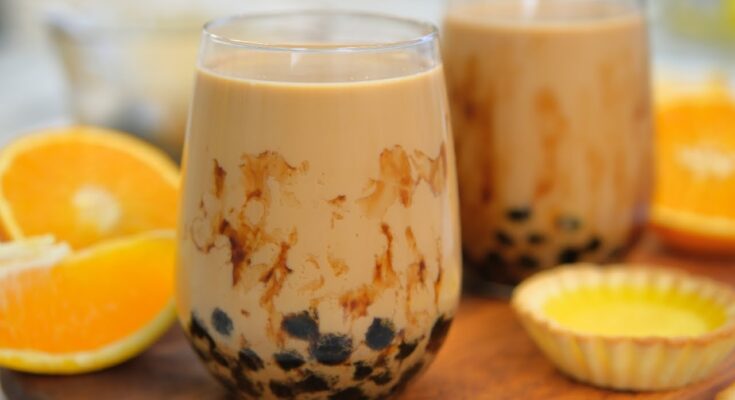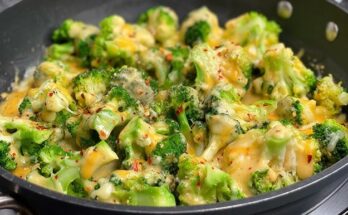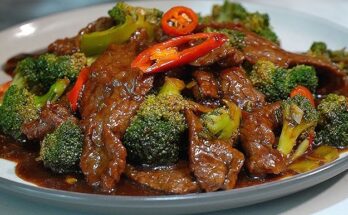Boba Milk Tea Recipe: There’s just something irresistibly comforting and fun about a tall glass of Boba milk tea—those chewy tapioca pearls at the bottom, the rich blend of milk and tea, and the burst of flavors with every sip.
Whether you’re a longtime fan or a curious newbie, learning how to make your own Boba milk tea at home is not only easy but incredibly satisfying.
This guide will take you step-by-step through the process, from picking the right ingredients to brewing the perfect cup of this trendy drink.
What is Boba Milk Tea?
Boba milk tea, also known as bubble tea or pearl milk tea, originated in Taiwan during the 1980s. It quickly became a cultural phenomenon thanks to its unique texture and customizable flavors. At its core, Boba milk tea is a cold or warm tea-based drink that includes milk (or non-dairy alternatives) and chewy tapioca balls known as “Boba” or “pearls.”
The pearls are what make this drink truly special—they add a playful, chewy bite that complements the smooth and sweet tea base. Depending on your mood or taste preferences, you can switch up the flavorings, the tea type, or even add different toppings like jelly, pudding, or popping boba.
The Popularity of Boba Around the World
From the streets of Taipei to cafes in New York, Boba milk tea has become a global sensation. It’s not just a drink—it’s a lifestyle. Social media platforms are flooded with creative variations and beautiful, colorful photos of this popular treat. Cities around the world now boast specialized Boba shops, and even mainstream coffee chains are catching on.
So why is Boba so beloved? It’s the perfect blend of texture, flavor, and personalization. People love that they can tailor each drink to their own taste—whether that’s extra pearls, reduced sugar, almond milk, or taro flavor. And the best part? Making it at home is easier than you think.
Ingredients You’ll Need
Core Ingredients for Classic Boba Milk Tea
To make the most traditional version of Boba milk tea, you’ll need the following:
- Tapioca pearls: The chewy “Boba” that give this drink its name.
- Black tea: Assam, Ceylon, or Earl Grey are popular choices for a strong, bold base.
- Milk: You can use whole milk, half-and-half, evaporated milk, or non-dairy options like almond, soy, or oat milk.
- Sweetener: Typically, simple syrup (sugar dissolved in water), honey, or brown sugar is used.
Each ingredient plays an important role. The tea provides the bold flavor, the milk adds creaminess, and the sweetener balances the bitter notes of the tea. Tapioca pearls, meanwhile, bring that signature texture that makes bubble tea so fun to drink.
Optional Add-ins and Flavor Variations
Here’s where you can get creative. Want to mix things up a little? Try these:
- Flavored syrups: Taro, matcha, strawberry, mango, lychee
- Jellies: Coconut jelly, grass jelly, lychee jelly
- Popping boba: Fruit juice-filled balls that burst in your mouth
- Fruit purees: For a more natural flavor profile
- Creamers: Sweetened condensed milk or coffee creamers for a richer texture
You can even add ice cream or whipped cream on top for an indulgent treat. The possibilities are endless, so don’t be afraid to experiment!
Tools Required for Making Boba Milk Tea
Kitchen Tools You’ll Need
Making Boba milk tea at home doesn’t require fancy equipment. Here’s what you’ll need:
- Pot: For boiling tapioca pearls.
- Strainer: To drain the cooked pearls.
- Large glass or mason jar: For serving the drink.
- Wide straw: Special Boba straws are a must to enjoy those chewy pearls.
- Teapot or kettle: For brewing tea.
- Measuring cups and spoons: Precision is key for consistency.
These basic tools are likely already in your kitchen, but if not, they are affordable and easy to find.
Where to Get Ingredients and Tools
If you’re wondering where to buy tapioca pearls or flavored syrups, don’t worry—options abound. You can find everything you need at:
- Asian supermarkets: Great for specialty ingredients like tapioca pearls and flavored jellies.
- Online retailers: Websites like Amazon and specialty tea shops carry a wide variety of Boba-making kits and ingredients.
- Local tea shops: Some bubble tea stores even sell DIY kits now.
Make sure to read the labels—some pearls cook faster than others (quick-cooking varieties are available), and some flavored syrups may be sweeter than expected.
How to Cook Tapioca Pearls
Step-by-Step Cooking Instructions
Cooking tapioca pearls is one of the most crucial steps in creating the perfect Boba drink. Follow this guide to get them just right:
- Boil water: Use at least 7-8 cups of water per 1 cup of dry tapioca pearls.
- Add pearls: Pour the pearls into boiling water and stir gently to prevent sticking.
- Cook uncovered: Let them boil for 20-30 minutes depending on size and brand. Stir occasionally.
- Simmer: After boiling, turn off the heat and let them sit covered for another 20 minutes.
- Drain and rinse: Use a strainer to remove the pearls and rinse them under cold water.
- Sweeten: Mix them with sugar syrup or honey while still warm so they absorb the sweetness.
How to Store Cooked Boba Properly
Tapioca pearls are best enjoyed fresh, but if you have leftovers, you can store them:
- Short term (within a few hours): Keep them at room temperature in a sugar syrup to prevent hardening.
- Do not refrigerate: Cold storage will make them tough and lose their chewiness.
- Reheat gently: If needed, reheat them by soaking in warm water for a few minutes.
Remember, freshness is key when it comes to that iconic chewy texture!
Brewing the Perfect Tea Base
Choosing the Right Tea for Your Drink
The tea is the heart and soul of your Boba milk tea. It provides that strong, aromatic base that perfectly balances the creaminess of the milk and the chewiness of the pearls. Choosing the right tea is essential, and while there are endless options, some stand out more than others:
- Black Tea: This is the most popular choice. Varieties like Assam, Darjeeling, and Ceylon have a robust flavor that cuts through the milk beautifully.
- Green Tea: For a lighter, more floral taste, green tea such as jasmine or sencha works well.
- Oolong Tea: This is a semi-oxidized tea that offers a complex flavor somewhere between green and black tea—perfect for those who want depth in their drink.
- Herbal and Fruit Teas: These are less traditional but offer fun, fruity twists. Think hibiscus, rooibos, or passionfruit.
Make sure you buy high-quality loose-leaf tea or premium tea bags for the best results. Avoid overly processed or artificially flavored teas, as they can throw off the natural balance of your drink.
Steeping Techniques for Maximum Flavor
To get the richest, most flavorful tea base, follow these steeping tips:
- Boil fresh water: Use filtered water if possible. For black tea, bring water to a rolling boil; for green tea, let it cool slightly before pouring.
- Measure your tea: Use about 1 teaspoon of loose tea or one tea bag per 8 oz cup.
- Steep for the right time: Black tea should steep for 4–5 minutes, green tea 2–3 minutes, and oolong 3–5 minutes.
- Strain immediately: Don’t let the leaves sit in the water too long—it can make the tea bitter.
- Cool it down: If you’re making iced milk tea, let your tea chill in the fridge for at least 30 minutes before mixing with milk and Boba.
You can also double the strength of your tea if you plan to serve it over ice so it doesn’t get diluted. Add sweetener while it’s still warm so it dissolves properly.
Assembling Your Boba Milk Tea
Putting It All Together – Step by Step
Now that your pearls are cooked, your tea is brewed, and your ingredients are ready, it’s time for the most satisfying part—putting it all together. Here’s how:
- Add tapioca pearls: Scoop ¼ to ½ cup of cooked Boba into a tall glass.
- Pour in sweetener: Drizzle 1–2 tablespoons of sugar syrup or honey over the pearls.
- Add ice (optional): If you want a cold drink, now’s the time to add ice.
- Pour tea: Fill the glass about ⅔ full with your brewed tea.
- Top with milk: Add your choice of milk until the glass is full. Stir gently to combine.
Use a wide straw and give it a swirl before sipping. That first taste—rich, creamy, sweet, and chewy—is what Boba dreams are made of.
Presentation Tips for the Perfect Look
Want to wow your friends or just snap a perfect Insta shot? Try these:
- Layered look: Add the syrup and pearls first, then ice, tea, and milk for that iconic layered look before stirring.
- Clear glass: Show off the pearls and swirling milk in a mason jar or clear tumbler.
- Toppings: Add whipped cream, caramel drizzle, or fruit chunks for extra flair.
Boba milk tea is as much about presentation as it is about taste. Have fun with it!
Customizing Your Boba Milk Tea
Adjusting Sugar and Milk Levels
One of the best things about making Boba milk tea at home is that you can adjust it exactly how you like it. Don’t like it too sweet? Cut back on the sugar. Prefer it creamier? Add more milk. Here’s a guide:
- Sweetness: Start with 1–2 tablespoons of syrup per drink and adjust to taste.
- Milk Ratio: A typical drink is about 70% tea to 30% milk. Play with the ratio based on your preference.
- Extra Flavors: You can infuse your milk or tea with cinnamon, vanilla, or even coffee for a bold twist.
Making it at home means there’s no “one size fits all.” You’re the barista!
Popular Variations to Try
Ready to branch out from the classic recipe? Here are some fun and delicious variations:
- Taro Milk Tea: Made with purple taro root powder or puree, offering a nutty, creamy flavor and beautiful lavender hue.
- Matcha Latte Boba: Green tea lovers will adore this one. Use matcha powder for a vibrant, earthy drink.
- Thai Tea Boba: Brewed with Thai tea leaves and sweetened condensed milk for a rich, orange-colored treat.
- Fruit Boba Teas: Use fruit purees or juices like mango, strawberry, or lychee for a fruity, refreshing take.
Switch up your tea base, experiment with plant-based milks, or combine flavors to discover your perfect Boba blend.
Tips and Tricks for the Best Homemade Boba Milk Tea
Common Mistakes and How to Avoid Them
Even though Boba milk tea is fairly simple to make, there are a few easy mistakes that can turn your dreamy drink into a disappointing one. Here are some common pitfalls and how to sidestep them:
- Overcooking or undercooking the pearls: Tapioca pearls need precise cooking. If they’re undercooked, they’ll be hard in the middle. If overcooked, they become mushy. Always follow the cooking time instructions on the package.
- Using weak tea: Your tea should be strong enough to stand up to the milk and sugar. Always double the amount of tea or steep for longer if you’re planning to serve it cold.
- Not sweetening the pearls: Boba on its own doesn’t have much flavor. Mixing them with syrup after cooking enhances their taste and texture.
- Refrigerating the pearls: Tapioca pearls harden and become unpleasant if kept in the fridge. Only cook what you plan to use within a few hours.
- Too much ice: It might be tempting to load up on ice, but that can dilute the flavor. Brew a stronger tea if you love ice-cold drinks.
Avoiding these slip-ups will help ensure each homemade Boba is as good (or better) than what you get at a shop.
Pro Tips for Ultimate Flavor and Texture
Want to take your Boba milk tea to the next level? Try these hacks:
- Infuse your syrup: Add ginger, vanilla, or cinnamon sticks to your simple syrup for an aromatic twist.
- Use brown sugar syrup: Gives your pearls a deep, caramel-like flavor that’s incredibly rich.
- Chill the tea overnight: Enhances the flavor and gives you a perfectly cold drink without watering it down.
- Add a pinch of salt: Just a tiny bit in your milk can balance out sweetness and bring out the flavors more.
- Make ahead: Brew large batches of tea and refrigerate them for Boba-on-demand throughout the week.
Homemade doesn’t mean basic. With these pro tips, your kitchen might just become your favorite Boba spot.
Healthier Boba Milk Tea Alternatives
Low-Sugar and Dairy-Free Options
Boba milk tea doesn’t have to be a guilty pleasure. With a few smart substitutions, you can make a version that fits into almost any diet.
- Skip the sugar syrup: Use natural sweeteners like stevia, monk fruit, or agave.
- Use unsweetened plant milks: Almond milk, oat milk, and soy milk work beautifully and cut calories too.
- Try homemade pearls: Control the ingredients and avoid artificial preservatives by making your own Boba.
- Portion control: Use smaller amounts of pearls—they’re delicious but high in carbs.
A classic Boba milk tea can contain over 300 calories, but with these changes, you can slash that significantly without compromising on taste.
Nutritional Breakdown of Traditional vs. Healthy Versions
| Component | Traditional Boba Tea (16 oz) | Healthier Version (16 oz) |
|---|---|---|
| Calories | 300–400 | 150–200 |
| Sugar | 30–50g | 5–10g |
| Fat | 5–8g | 2–4g |
| Tapioca Pearls | 100–150 cal | 50–75 cal (reduced quantity) |
| Milk | Whole milk | Almond/Oat Milk |
These numbers show how easy it is to enjoy Boba without overindulging. A little mindfulness goes a long way.
Boba Milk Tea for Every Season
Summer Sips: Refreshing Iced Variations
When the weather heats up, nothing hits the spot like a cold, fruity Boba drink. Here are some seasonal favorites:
- Mango Milk Tea: Mix mango puree with black tea and milk.
- Strawberry Matcha: Layer strawberry syrup, oat milk, and matcha.
- Lychee Green Tea: A non-dairy, fruit-forward favorite.
- Frozen Boba Slushies: Blend ice with fruit and tea for a drink-meets-dessert.
Top it off with fresh fruit or a citrus twist for the ultimate poolside sipper.
Cozy Winter Warmers with a Boba Twist
Boba isn’t just for hot days! During the colder months, warm versions of Boba milk tea bring comfort in every sip:
- Hot Thai Milk Tea: Sweet, creamy, and warming with a deep spice.
- Chai Boba Latte: Combine spicy chai tea with warm milk and pearls.
- Hot Chocolate Boba: Swap the tea for cocoa for a kid-friendly treat.
- Brown Sugar Ginger Tea: Great for soothing throats and warming bellies.
Just warm up your pearls before adding them to the drink—never boil them again or they’ll fall apart.
FAQs about Boba Milk Tea Recipe
1. Can I make Boba pearls from scratch at home?
Yes, but it requires tapioca starch, water, and patience. While doable, store-bought pearls are quicker and more consistent for beginners.
2. How long do cooked tapioca pearls last?
Fresh is best, but you can store them in sugar syrup at room temperature for up to 4 hours. Avoid refrigerating them as they harden.
3. What’s the best milk for dairy-free Boba?
Oat milk offers a creamy texture, while almond milk is lighter. Soy milk is great if you want a thicker consistency.
4. How do I make my Boba tea less sweet?
Reduce or eliminate the syrup, and use unsweetened tea and milk. You can also control the sweetness by adjusting the steeping time and the type of tea.
5. Can I reuse leftover tea for Boba?
Absolutely! Just make sure it’s stored in the fridge and used within a few days. Stronger tea works better after chilling.
Conclusion
Making Boba milk tea at home is more than just a recipe—it’s a creative and delicious experience. From choosing your favorite tea base and cooking the perfect pearls to experimenting with flavors and textures, the possibilities are endless. Whether you’re trying to replicate your favorite shop drink or invent something totally new, this step-by-step guide gives you all the tools and tips you need.
So why wait in line or pay a premium when you can whip up the perfect cup in your own kitchen? Grab your ingredients, get brewing, and start sipping—you’ll be surprised just how easy and fun it is.



